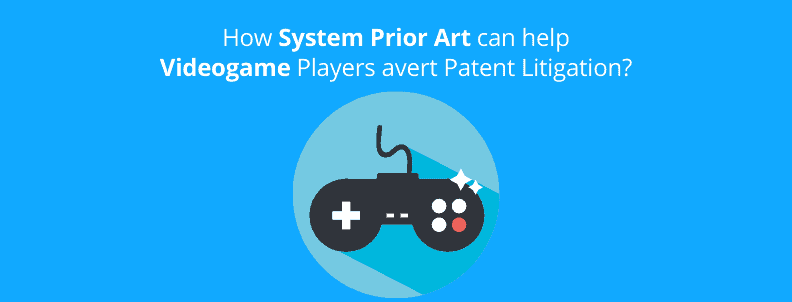“Gamers are the most passionate people in the world and it’s painful when you make them unhappy”.
Jack Tretton, President, and CEO of Sony Computer Entertainment America (2013)
We have to agree with Mr. Tretton’s characterization, for a lot of us, are a part of this gaming coterie. Talking about our coterie, another segment you and I are related to is the IP industry. A concoction of these two, seemingly unrelated sectors, gives rise to the IP of the gaming industry. So when we received an invalidation request for patents-in-suit related to video games, we jumped aboard without hesitation, unknown of what was in store for us.
Ready to take a closer look?
Let’s start with some technical details of what we were trying to find. The target patents were focused on multiplayer video games where the primary features in focus were:
- providing bonuses to players based on their skill levels and
- sharing of in-game items between players ( This particular feature involves deeper intricacies).
The video games in litigation were, and still are, one of the most widely played mobile multiplayer games of all time, frequently featured in the top-grossing charts. The stakes were high and a plan was put in place. Having spent countless hours playing the same video game, we wanted to bring our A-game to the project, leaving no stone unturned to defend a game all of us thoroughly enjoyed.
We first built an understanding of where prior art could be found
Those who are familiar with the process of finding prior art know that almost always it is akin to searching for water on Mars. One needs a well-thought plan, a team of skilled personnel, and most importantly, have an idea of where to look.
In ordinary searches, you have conventional search strategies at your disposal: Figure out some promising keywords and classifications, prepare search queries and start analyzing patents. But then gaming invalidations are no ordinary cases. Just like the video games out there, in prior art searches too, you have to navigate through a complex territory to obtain what you are after.
Even before we commenced work on this project, we knew that an orthodox approach would not necessarily yield 102-type prior art. This is where our years of gaming experience played a pivotal role.
We can find prior art in games but there are so many games to explore
First, we filtered out the different video game genres which we believed would give us solid prior art. In this particular case, we realized that the best shot of identifying prior art was role-playing games (RPGs).
But only genre-based filtering was not sufficient. There are countless RPG games in the market and you cannot afford to spend hours upon hours just to review a single game.
Exploiting our knowledge, we further decontaminated the list of RPG games and meticulously checked the most promising ones. One by one, games kept getting eliminated from our list as some relevant features were added via post-launch updates, as is usually the case with video games.
Next, we shortlisted a few promising candidates for further exploration
With some promising candidates shortlisted, we then decided to explore reviews by critics/users. Reading through articles on websites like IGN, Eurogamer, Gamespot, Giantbomb, PC Gamer, and MMO Reviews to name a few, all but solidified our conviction that we were on the right track.


Snapshots from a game review website describing in-game functionality
Exploring game footage to fill the gaps in the existing prior art
There were still some gaps in the existing prior art so, we decided to review actual game footage. This is another solid avenue for locating prior art since a massive amount of footage is uploaded/streamed to websites like YouTube and Twitch. Unlike text-based content, you can’t search for content within videos to make the process swift; rather, the only way is to watch the content to conclude its usability. Again, you need to have a clear picture in mind while shortlisting games for video review, otherwise, you might end up spending countless hours watching videos for nothing.
With some promising videos shortlisted, the work was almost done. That’s where the most important part of our search came into play, one which is often overlooked.
Digging into the details aka exploring Strategy Guides
Strategy Guides – Strategy guides such as those published by Prima Games, Piggyback Interactive are proper books, quite often spanning a couple of hundred pages.
Online reviews generally cover the game narrative, a fleeting analysis of the gameplay, and the shortcomings of video games. Strategy guides, on the other hand, are detailed accounts of how to progress through a game, and most importantly, they cover the underlying gameplay mechanics/systems in detail.

Snapshot of the table of contents of a game strategy guide
While I can’t divulge more details for the sake of confidentiality, these strategy guides were our bridge to prior art land. Using these guides/books, we were able to piece together a strong invalidation argument from both patent and non-patent literature (above). Video games that initially appeared to only cover certain broader aspects of the target claim appeared bulletproof when presented with supporting documentation spanning videos, reviews, and strategy guides.
When we shared the results with the client, he was super excited and quipped:
“This is the reason why I come to GreyB. You guys make sure you leave no avenue unexplored. Kudos!”
What can we say, that’s just how we roll. We have covered our search approach in detail in our other articles, and if you’d want to know more about our services or want us to help find prior art to invalidate that patent currently in litigation, reach out to us at and we will take care of the details.
Read this if you’re working in the video game industry.
Everyone loves playing video games because they are the best form of entertainment. If you don’t agree, the below stats covering the surge in videogame revenue should change your point of view. In fact, video games are a bigger industry than movies and North American sports combined.

Source: Market Watch
A recent market report touts the global gaming industry has reached a staggering $180 billion in 2020, a 20% rise in part because of the COVID pandemic.
Further, the recent release of next-generation video game consoles by industry giants Xbox (Microsoft) and Playstation (Sony) in Q4 2020, and possibly an iteration of Nintendo’s Switch on the cards, will further amount to YoY growth of the gaming industry.
If you go by sales numbers, the Nintendo Switch system has already sold close to 80 million units. Among these sales numbers of Nintendo and other video game consoles, a new trend can be seen.
If one looks at the recent litigation data of Nintendo, it could be seen that players are ready to battle with the industry giant in hopes of a payday.
| FILED DATE | CASE NAME | CASE NUMBER | JURISDICTION | STATUS |
| 03/10/2021 | BIOCONTROL LLC v.Nintendo of America | 6:21-cv-00243 | Western District of Texas | Open |
| 03/05/2021 | M-Red Inc v. Nintendo Co., Ltd. | 2:21-cv-00076 | Eastern District of Texas | Open |
| 08/18/2020 | Genuine Enabling Technology v. Nintendo Co., Ltd. | 20-2167 | Federal Court | Open |
| 03/27/2020 | Portable Gaming Console Systems with Attachable Handheld Controllers and Components Thereof II | 337-TA-1197 | ITC | Pending before the ALJ |
| 03/29/2018 | Gamevice, Inc. v. Nintendo Co., Ltd, et al | 3:18-cv-01942 | Northern District of California | Open |
| 06/26/2020 | Nintendo of America et al v. Gamevice Inc. IPR of ‘393 | IPR2020-01197 | PTAB Tech Center:3700 | No Claims Instituted |
Recent litigations involving Nintendo (Details taken from RPX)
In fact, just a few months back, the USITC instituted Gamevice’s investigation against Nintendo for the popular Nintendo Switch system (although the final ruling was in favor of Nintendo).
A quick search also reveals a recent case (6:20-cv-00455) filed by WSOU Investments against Microsoft, alleging patent infringement by the popular Xbox consoles.
With the latest generation of video game consoles, by Sony and Microsoft, already crossing several million units of sales and the supersonic expansion of the gaming industry clubbed with recent filings – Could this be a sign of a newfound interest in video game litigation?
If you’re an executive from any of the above-mentioned console companies, you need to be aware of this trend and have a strategy in hand to curb this problem area.
If you’re having trouble crafting the right strategy, we can help you chalk one.
Authored by: Prateek Gandotra and Gaurav Dhiman, Prior Art Team.











